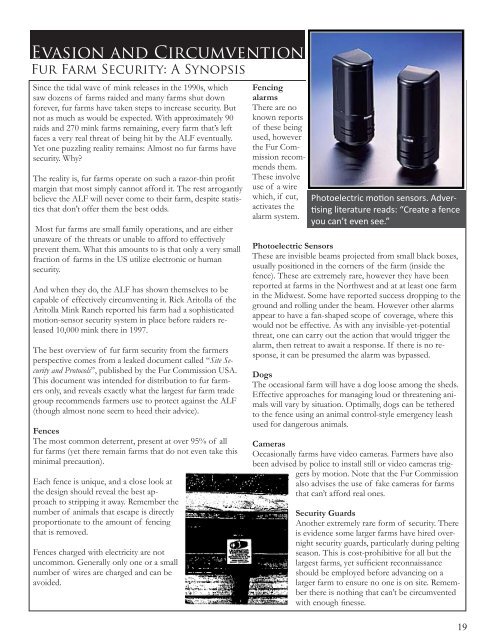You also want an ePaper? Increase the reach of your titles
YUMPU automatically turns print PDFs into web optimized ePapers that Google loves.
Evasion and Circumvention<br />
Fur Farm Security: A Synopsis<br />
Since the tidal wave of mink releases in the 1990s, which<br />
saw dozens of farms raided and many farms shut down<br />
forever, fur farms have taken steps to increase security. But<br />
not as much as would be expected. With approximately 90<br />
raids and 270 mink farms remaining, every farm that’s left<br />
faces a very real threat of being hit by the ALF eventually.<br />
Yet one puzzling reality remains: Almost no fur farms have<br />
security. Why?<br />
The reality is, fur farms operate on such a razor-thin profit<br />
margin that most simply cannot afford it. The rest arrogantly<br />
believe the ALF will never come to their farm, despite statistics<br />
that don’t offer them the best odds.<br />
Most fur farms are small family operations, and are either<br />
unaware of the threats or unable to afford to effectively<br />
prevent them. What this amounts to is that only a very small<br />
fraction of farms in the US utilize electronic or human<br />
security.<br />
And when they do, the ALF has shown themselves to be<br />
capable of effectively circumventing it. Rick Aritolla of the<br />
Aritolla Mink Ranch reported his farm had a sophisticated<br />
motion-sensor security system in place before raiders released<br />
10,000 mink there in 1997.<br />
The best overview of fur farm security from the farmers<br />
perspective comes from a leaked document called “Site Security<br />
and Protocols”, published by the Fur Commission USA.<br />
This document was intended for distribution to fur farmers<br />
only, and reveals exactly what the largest fur farm trade<br />
group recommends farmers use to protect against the ALF<br />
(though almost none seem to heed their advice).<br />
Fences<br />
The most common deterrent, present at over 95% of all<br />
fur farms (yet there remain farms that do not even take this<br />
minimal precaution).<br />
Each fence is unique, and a close look at<br />
the design should reveal the best approach<br />
to stripping it away. Remember the<br />
number of animals that escape is directly<br />
proportionate to the amount of fencing<br />
that is removed.<br />
Fences charged with electricity are not<br />
uncommon. Generally only one or a small<br />
number of wires are charged and can be<br />
avoided.<br />
Fencing<br />
alarms<br />
There are no<br />
known reports<br />
of these being<br />
used, however<br />
the Fur Commissionrecommends<br />
them.<br />
These involve<br />
use of a wire<br />
which, if cut,<br />
activates the<br />
alarm system.<br />
Photoelectric motion sensors. Advertising<br />
literature reads: “Create a fence<br />
you can’t even see.”<br />
Photoelectric Sensors<br />
These are invisible beams projected from small black boxes,<br />
usually positioned in the corners of the farm (inside the<br />
fence). These are extremely rare, however they have been<br />
reported at farms in the Northwest and at at least one farm<br />
in the Midwest. Some have reported success dropping to the<br />
ground and rolling under the beam. However other alarms<br />
appear to have a fan-shaped scope of coverage, where this<br />
would not be effective. As with any invisible-yet-potential<br />
threat, one can carry out the action that would trigger the<br />
alarm, then retreat to await a response. If there is no response,<br />
it can be presumed the alarm was bypassed.<br />
Dogs<br />
The occasional farm will have a dog loose among the sheds.<br />
Effective approaches for managing loud or threatening animals<br />
will vary by situation. Optimally, dogs can be tethered<br />
to the fence using an animal control-style emergency leash<br />
used for dangerous animals.<br />
Cameras<br />
Occasionally farms have video cameras. Farmers have also<br />
been advised by police to install still or video cameras triggers<br />
by motion. Note that the Fur Commission<br />
also advises the use of fake cameras for farms<br />
that can’t afford real ones.<br />
Security Guards<br />
Another extremely rare form of security. There<br />
is evidence some larger farms have hired overnight<br />
security guards, particularly during pelting<br />
season. This is cost-prohibitive for all but the<br />
largest farms, yet sufficient reconnaissance<br />
should be employed before advancing on a<br />
larger farm to ensure no one is on site. Remember<br />
there is nothing that can’t be circumvented<br />
with enough finesse.<br />
19



